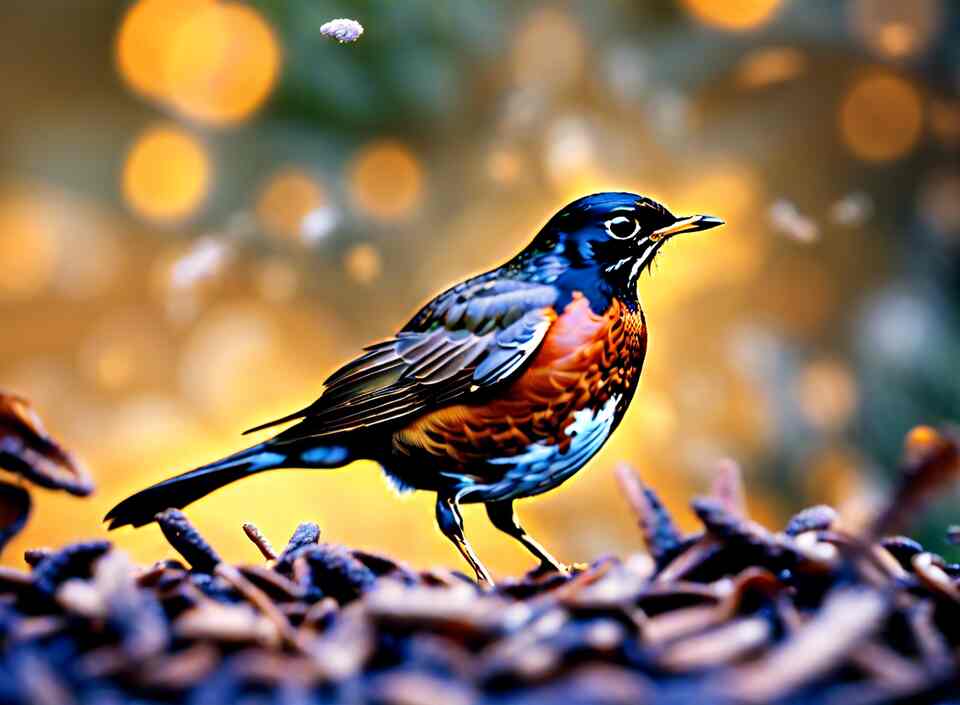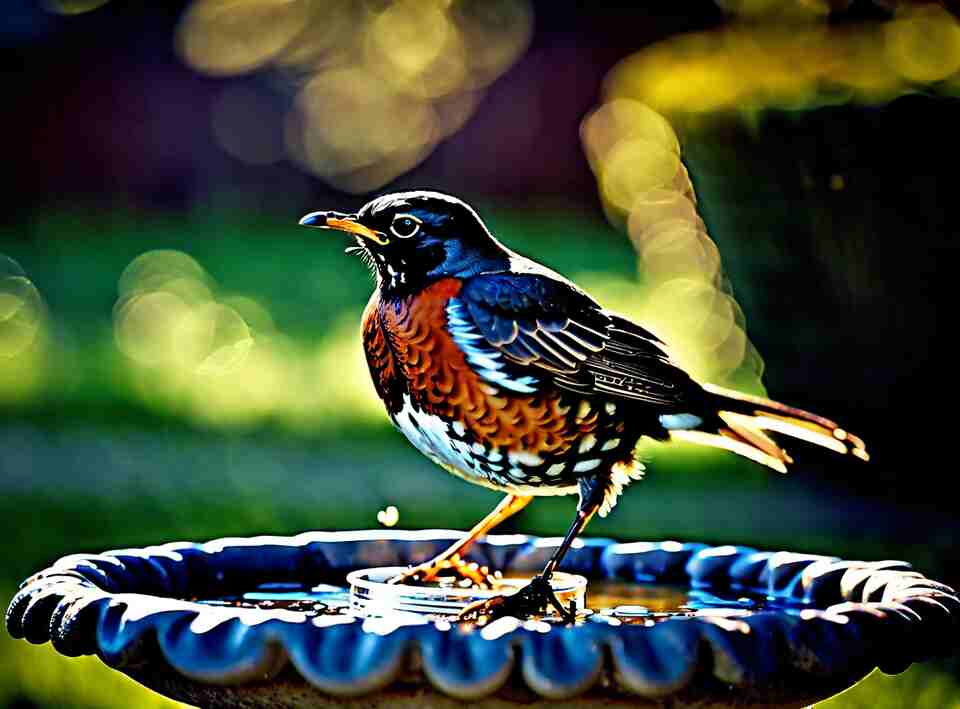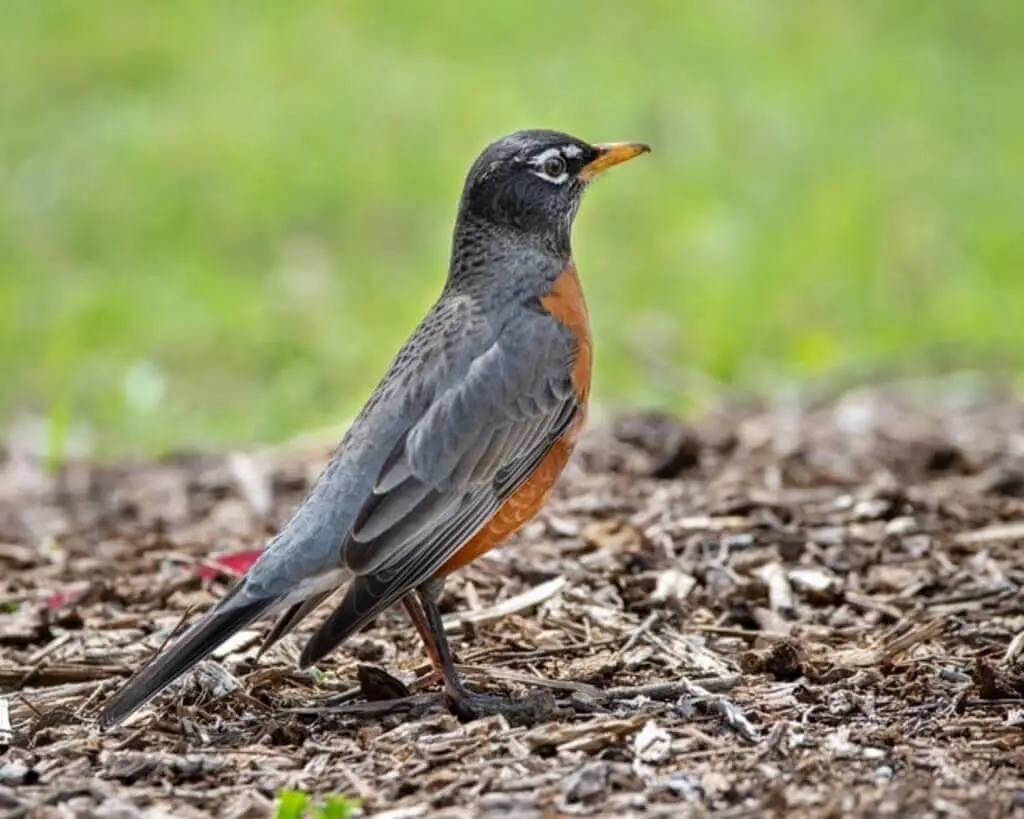
Hey there! Ever found yourself wishing for a bit more company in the yard? I sure have! Well, guess what? Today, let’s chat about bringing in some cheerful robins to liven up the place. Imagine stepping outside to the sound of their chirps – doesn’t that sound delightful?
Let’s make our yard their favorite hangout spot, where they can feel right at home with us. Ready to turn our space into a robin paradise? Let’s do this!
Table of Contents
Key Takeaways:
- Create a welcoming environment with plenty of natural food sources like berries and insects.
- Offer fresh water for drinking and bathing to attract robins to your yard.
- Plant native trees and shrubs to provide shelter and nesting sites.
- Minimize pesticide use to maintain a healthy ecosystem.
- Keep cats indoors to protect visiting robins from predators.
- Enjoy the sights and sounds of robins in your yard by providing a cozy atmosphere they’ll love.

Enticing Robins to Your Outdoor Sanctuary
Attracting Robins to Your Outdoor Oasis
Robins, those beloved harbingers of spring, can bring a delightful touch of liveliness to any outdoor space. With their cheerful songs and vibrant red breasts, these charming birds can transform your yard into a veritable avian paradise. If you’re eager to invite these feathered friends to make your outdoor sanctuary their home, read on for some proven strategies.
Provide a Reliable Water Source
Robins are drawn to areas with consistent access to water. Consider installing a bird bath or a shallow dish filled with clean, fresh water. Positioning it in a visible location near vegetation will make it an irresistible watering hole for your feathered guests. Remember to keep the water clean and replenished regularly to ensure it remains inviting.
Offer a Diverse Buffet of Food
Robins are omnivores, relishing a variety of food sources. Scatter a mix of mealworms, suet, and fruit pieces on the ground or in ground feeder trays around your yard. Additionally, encourage natural food sources by planting berry-producing shrubs and trees, such as holly, serviceberry, and dogwood. These not only provide sustenance but also offer shelter and nesting sites.
Create Inviting Nesting Spots
Robins often seek out spots with a mix of dense vegetation and open ground for their nests. Consider strategically placing a few nesting platforms in sheltered areas, such as under the eaves of your home or within the branches of tall shrubs. Avoid pruning or cutting back vegetation during the nesting season to maintain their preferred nesting sites.
Incorporate Native Plants
Native plants are a magnet for robins, as they provide the insects, berries, and other food sources these birds rely on. Opt for a variety of native flowers, shrubs, and trees that offer year-round sustenance and shelter. Some excellent choices include serviceberry, Eastern red cedar, and coneflowers.
Minimize Disturbances
Robins are sensitive to human activity and can be easily startled. Try to maintain a peaceful, low-disturbance environment in the areas you want to attract them to. Avoid excessive foot traffic, loud noises, and the presence of pets or large predators, as these can deter robins from settling in.
Be Patient and Observe
Attracting robins to your yard may take some time and persistence. Observe the natural patterns and behaviors of these birds, and make adjustments to your habitat accordingly. It’s also important to be patient and give them time to discover and become comfortable in their new surroundings.
By implementing these strategies, you’ll be well on your way to creating an inviting oasis that robins will be eager to call home. Enjoy the sights and sounds of these delightful birds as they bring a touch of spring’s vitality to your outdoor haven.
Cultivating a Robin-Friendly Environment
Providing the Right Habitat: Attracting Robins to Your Yard
Robins are beloved backyard birds known for their cheerful songs and vibrant red breasts. If you’re looking to invite these charming feathered friends to your outdoor space, there are several steps you can take to create a robin-friendly environment. By understanding their habitat preferences and offering the resources they need, you can cultivate a welcoming oasis that will delight you with the presence of these delightful avian neighbors.
Food Sources for Robins
Robins are omnivorous, feeding on a variety of insects, worms, and berries. To attract them to your yard, focus on providing a diverse array of food options. Plant native shrubs and trees that produce berries, such as holly, serviceberry, and mulberry. These will offer a reliable source of sustenance, especially during the colder months when other food sources may be scarce.
Additionally, maintain a well-watered lawn or garden bed, as robins love to forage for earthworms and other invertebrates in moist soil. Consider installing a birdbath or shallow dish of water to give them a convenient place to drink and bathe. Supplementing their diet with high-protein suet or mealworms in feeders can also be beneficial, particularly during the breeding season when they require extra nutrition to fuel their nesting activities.
Nesting Opportunities
Robins are cavity-nesting birds, meaning they prefer to build their nests in sheltered, secure locations. Offer them suitable nesting sites by strategically placing birdhouses or allowing natural vegetation to flourish. Look for areas with dense, evergreen foliage, such as dense shrubs or the branches of coniferous trees, where they can construct their mud-and-grass nests.
If you have deciduous trees in your yard, leave some dead or dying branches intact, as robins often utilize these for nesting. Avoid excessive pruning or clearing of vegetation, as this can eliminate potential nesting sites and make your yard less appealing to these birds.
Providing Cover and Perches
Robins thrive in yards that offer a variety of perching spots and sheltered areas. Install bird baths, birdfeeders, and birdbaths on sturdy, elevated platforms or tree branches, giving the robins a safe place to rest and survey their surroundings.
Additionally, maintain a mix of dense shrubs, tall grasses, and small trees to provide the robins with adequate cover and protection from predators. These sheltered areas can serve as nesting sites, as well as safe havens for the birds to retreat to when they feel threatened.
Avoiding Pesticides and Chemicals
Robins are sensitive to the use of pesticides and other chemicals in the landscape. Refrain from using harsh herbicides, insecticides, and fertilizers, as these can be harmful to the birds and the insects they rely on for food. Instead, opt for natural, organic gardening methods that promote a healthy, balanced ecosystem.
By creating a pesticide-free environment, you’ll not only attract robins but also support the overall biodiversity of your yard, benefiting a wide range of other beneficial insects and wildlife.
Patience and Observation
Attracting robins to your yard may take some time and patience, as these birds are highly territorial and may need to acclimate to the changes you’ve made. Observe your yard carefully and make note of any areas the robins seem drawn to. This will help you fine-tune your efforts and make the necessary adjustments to create an even more inviting habitat.
Remember, providing the right combination of food, nesting opportunities, and protective cover is key to welcoming robins into your outdoor space. With a little effort and a keen eye, you can transform your yard into a thriving, robin-friendly oasis that you and your feathered friends can both enjoy.

Conclusion
Attracting robins to your yard can be a delightful and rewarding experience, as these charming birds not only bring vibrant colors and cheerful songs but also play a vital role in the ecosystem. By carefully cultivating a robin-friendly environment, you can transform your outdoor space into a true sanctuary for these feathered friends.
One of the key aspects of enticing robins is providing a diverse and abundant food source. Robins are omnivorous, relishing a wide range of sustenance, from insects and berries to mealworms and suet. a variety of bird feeders, strategically placed within your yard, can significantly increase the likelihood of robins taking up residence. Additionally, planting native shrubs and trees that bear fruits and berries popular with robins, such as dogwoods, hawthorns, and holly, can create a natural and sustainable food supply.
Ensuring a reliable water source is another crucial element in creating a robin-friendly environment. Robins require access to clean, fresh water for drinking and bathing, and they are particularly drawn to shallow birdbaths or small ponds. Positioning these water features in areas with ample cover, such as near bushes or trees, can provide the robins with a sense of security and protection from predators.
Shelter and nesting sites are also fundamental considerations when cultivating a robin-friendly yard. Robins typically build their nests in the crooks of trees, on ledges, or within dense shrubs and bushes. a variety of these nesting sites throughout your outdoor space can increase the chances of robins choosing your yard as their home. Additionally, providing birdhouses specifically designed for robins can offer an attractive alternative nesting option.
Maintaining a pesticide-free and chemical-free landscape is another essential aspect of creating a robin-friendly environment. Robins, like many other birds, are sensitive to the harmful effects of pesticides and herbicides, which can contaminate their food sources and nesting areas. By opting for organic gardening practices and natural pest control methods, you can ensure a safe and healthy habitat for these delightful birds.
Embracing the natural rhythms and behaviors of robins can greatly enhance your chances of attracting and maintaining a thriving robin population in your yard. Understanding the seasonal patterns of these birds, such as their breeding and migration cycles, can help you time your efforts for maximum impact. Additionally, respecting the robins’ territorial nature and avoiding excessive disturbance during nesting season can contribute to their overall well-being and encourage them to return year after year.
By implementing these strategies and cultivating a truly robin-friendly environment, you can transform your outdoor space into a vibrant avian sanctuary. The sight of robins hopping across your lawn, the sound of their melodic songs, and the joy of witnessing their nesting and rearing activities can bring a sense of wonder and connection to the natural world.
Embracing these charming birds and creating a nurturing habitat for them not only benefits the robins themselves but also enhances the overall biodiversity and ecological balance of your local ecosystem. So, let’s embark on this journey of transforming your yard into a haven for these remarkable feathered residents, and savor the delights they bring to your outdoor oasis.



